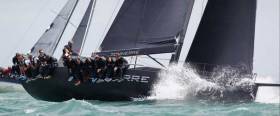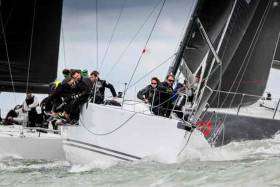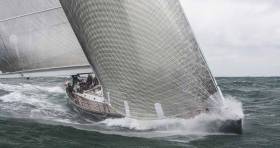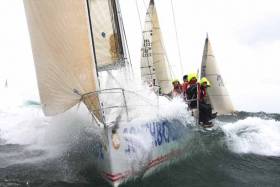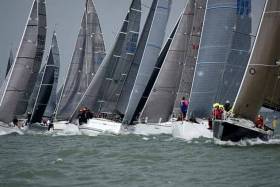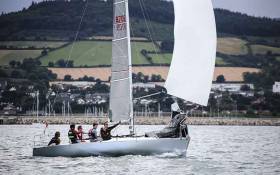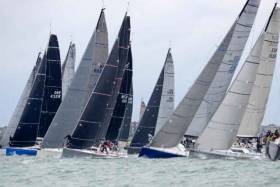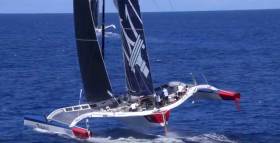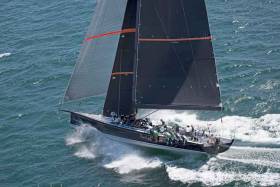Displaying items by tag: RORC
RORC 2017 Season's Points Championship Preview
Over 500 yachts are taking part in the 2017 RORC Season's Points Championship. Over 5000 sailors from all over the world will race in the biggest offshore sailing competition in the world. While this year the 2017 Rolex Fastnet Race is the showcase event, there are fourteen testing races that make up the championship, and every race has its own coveted prize for the overall winner and for class honours. For 2019 a second Irish race is hoping to be added to the series.
The 2017 RORC Season's Points Championship destinations include the Caribbean islands of Antigua and Virgin Gorda, plus the Spanish island of Lanzarote. There are seven European destinations: Belgium, France, Great Britain, Guernsey, Ireland, Malta, and the Netherlands. Five races are to count for Class Honours and the highest total score will designate the winner Overall racing under IRC.
RORC Commodore, Michael Boyd from Dublin's Royal Irish Yacht Club will be racing Lisa, in IRC One. Owned by Suzi and Nick Jones, the British Bénéteau 47.7 was last year's overall winner with Michael Boyd taking part in a number of races, including the Round Ireland, with the team.
"The RORC Season Points Championship is seriously difficult to win especially in a Rolex Fastnet year when there are many boats and the competition is tough. This year, I have chartered Nick and Suzi Jones’ Lisa and we have put a squad together to take up the challenge and it is going to be hard to win again.” commented Michael Boyd. “This will also be my last season as Commodore of the RORC and I wish to pass on the honour with the club in good health. One of my key goals is to increase the activities of the club internationally. Over a third of our club members are from overseas and we have yachts racing under the club's IRC rating rule all over the world. The Rolex Fastnet Race is one of the great races to win but to win any of the RORC races throughout the championship will a moment to savour.”
Cervantes Trophy Race
Start: 29th April, 2017
Course: Squadron Line, Cowes – Le Havre
Distance: 110-160 miles (Channel Marks may be included).
The first European race of the 2017 RORC Season's Points Championship will be the Cervantes Trophy Race, 100 yachts are expected to start from the Yacht Squadron Line.
Dutch Grand Master, Piet Vroon is back, as skipper of Ker 51, Tonnerre 4, taking another tilt at the championship in IRC Zero. In IRC One, Alan Hannon's RP45, last year's Best Overseas Yacht will be racing. In IRC Two, Michael Boyd's Lisa is the highest rated boat, and sees Gilles Fournier's French J/133 Pintia as one of the teams to beat.
“The Cervantes Trophy is our first race of the season and we will discover how good the competition is.” Commented Gilles Fournier. “We aim to do well in our class, as for the overall, luck is always an important factor. The Rolex Fastnet is attracting a big fleet, so winning our class as we did the last two years will not be easy.”
In IRC Three, a huge variety of yachts will be competing from elegant Swans to lightweight JPKs. With such a diversity in the fleet, the weather will play a crucial part in favouring races for displacement yachts such as Ben Morris's Swan 55 yawl, Lulotte and light weight flyers like Richard Palmer's JPK 10.10 Jangada. The armed forces will do battle in J/109s, the Royal Armoured Corps’ Ajax and the Royal Navy Sailing Association's Jolly Jack Tar are bound to have a close conflict.
Frers 45, Scaramouche will be sailed by the Greig City Academy, to kick off their Rolex Fastnet campaign The school from Harringay, London will become the first State School to enter the Rolex Fastnet Race, if they complete their qualification requirements. Four Sixth Formers have received their RYA Day Skipper qualification and the rest of the crew will be selected after taking their RYA Day Skipper Course. Half of the crew must now race 300 miles to qualify and there are First Aid and Offshore Special Regs Requirements.
Gregg School pupil, Shabazz Patterson, is excited about the chance to race in the Rolex Fastnet:
“It’s a big challenge for us. You have to be alert all the time on deck, everything can be still with no other boats in sight and then there will be a sudden change in the direction of the wind and it all becomes very intense as you tack to change course. We’ll be working in shifts over the four days. You think you won’t sleep between shifts, especially if it’s choppy, but as soon as you get into the berth you fall asleep because you’re just so physically tired.”
Seven Class40s will be racing to Le Havre, including RORC Transatlantic Race winners, Halvard Mabire and Miranda Merron in Campagne de France. (Arthur Daniels/RORC)
IRC Four is expected to be the largest class racing for the Cervantes Trophy, last year's class winner Noel Racine's French JPK 10.10 Foggy Dew has the highest rating in the class for the Cervantes Trophy. Previous Cervantes Trophy winner, Winsome skippered by Harry Heijst, will be hoping for suitable heavy weather to challenge the lighter displacement yachts. 20 teams will be racing in the gutsy IRC Two Handed Class with a fleet of seven short handed Class40s also entered, including RORC Transatlantic Race winners, Halvard Mabire and Miranda Merron in Campagne de France.
Speaking on behalf of the Société des Regates du Havre, Christophe La Chevre promises a warm welcome in Le Havre for the finishing teams. “All competing sailors will be very welcome with free dockage for 24 hours. The club will stay open all night on Saturday. I recommend booking a table for Sunday lunch (+33 235 412100 email: [email protected]). The restaurant has a very beautiful view. It is also the 500th birthday of Le Havre City, so there are many things to explore.”
Fifty Cruiser Racers Compete At RORC Easter Challenge
Across the 50 boat fleet competing at the RORC's three day long domestic season opener, that doubles as its annual training regatta, it was close across most classes, but none more so than IRC One writes James Boyd. In this, Mike Greville's sparkling Ker 39, Erivale III managed to lose her three point lead in yesterday's opening round the cans race and the victor was only decided on the final, head down, charge for the finish line in race two.
Three races were scheduled Sunday, but the wind dropped as the new breeze attempted to settle towards the end of the first race, causing the course to be shortened for IRC Two and Three. With the wind shifting dramatically, it took three attempts to get what was to be the second and final race underway.
Within IRC One, there was a match race between the two Mark Mills-designed MAT 1180s. Tor McLaren's two week old Gallivanter got its first taste of glory, winning today's opening race, However sistership, Christian Zugel's Tschuss, finished seven points ahead overall.
Star performer throughout the regatta was Sir Keith Mills' Invictus in the FAST 40+ class, racing within IRC One. With a 1-3 today, the black Ker 40+ won the regatta by a mighty 11 points. However it was not easy and all five of the FAST 40+ had their moments with Tony Dickin's Jubilee looking particularly strong today, leading the opening stages of race two, which was eventually won by Mark Rijkse's 42° South.
In IRC Two, a late charge from RORC Admiral Andrew McIrvine on La Reponse was enough to get his First 40 onto the podium but not enough to make an impression on the race for the lead between David Franks' JPK 10.10 Strait Dealer and Redshift Reloaded, the Sun Fast 3600 belonging to Ed Fishwick
Full results here
Time was when the Dun Laoghaire to Dingle Race was promoted as a handy way to position your little old cruiser in West Kerry to be nicely placed to make her way in gentle hops back to her home port on the south or east coast, ambling in leisurely stages along one of the finest cruising grounds in the world writes W M Nixon.
It was envisaged primarily as a sort of enlarged club race, the club setting the tone being the National Yacht Club in Dun Laoghaire. There, enthusiastic members and Dingle race plotters Martin Crotty, Peter Cullen and Brian Barry added a further attraction when promoting the first race, as it drew nearer in 1993, by suggesting that real dyed-in-the wool cruising types might find the race of interest if they were thinking of continuing with a clockwise cruise on round Ireland.
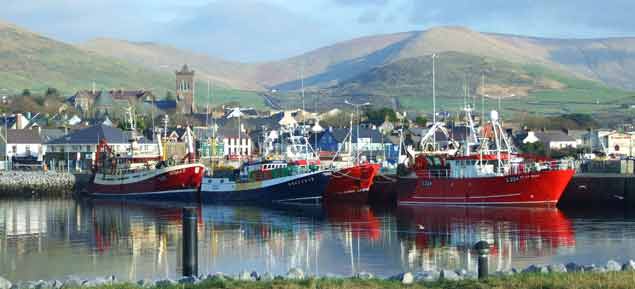 Dingle Harbour makes for an attractive destination...
Dingle Harbour makes for an attractive destination...
 …while its marina is enticing for cruisers and racers alike
…while its marina is enticing for cruisers and racers alike
Lovely idea. But so far as I know – though it’s very much hoped that I’ll be rapidly informed otherwise – it is this goggle-eyed wordsmith focused on his ancient computer screen who is still the only cruiser-racer skipper who has completed the Dun Laoghaire to Dingle Race, and then cruised on round Ireland.
We did it in handy stages, leaving the boat in Dingle for ten days after the race was completed to return home to the word-production coalface, then going on to leave her on a mooring we’d laid at Arbear at the head of Clifden Bay after we’d cruised the Aran Islands and Connemara in detail, followed by another return home for the manufacture of merchandisable verbiage. Then the third stage was home to Howth round the top, with Donegal doing its best to rival Kerry for dramatic scenery.
However, that was all a very long time ago. In fact, it was so long ago it was the first time I’d sailed with a proper pair of Dubarry Shamrock Goretex boots. I’d previously had an experimental leaky pair from a different manufacturer with which I’d persisted for years, so I can still remember the sheer joy of dry warm feet whatever the weather after the genuine Dubarrys had been deployed.
But enough of such ramblings - even if it does serve to remind us of the way the Dun Laoghaire to Dingle Race has become a much-loved part of our sailing world. And as for the reason for people not cruising on round Ireland when being in Dingle leaves them so handily placed for continuing the circuit - the answer is simple. The fact is that the course of almost 300 miles has taken them as swiftly as possible past some of the most glorious cruising places in Ireland, and the only way the skipper can keep his shipmates plugging on is by swearing on all that is holy that they’ll cruise gently back the same way in a much more civilised style.
In such circumstances, you’re whistling against the wind in trying to sell the coast of Connacht as the more interesting way to get home. Yet from an early stage, even the notion of the Dingle dash as having a strong cruising orientation hasn’t really held up for a significant part of the entry. People go into it with every intention of winning, and the talk of conveniently positioning the boat for a spot of cruising in Kerry and West Cork has only been smoke and mirrors.
![]() The Yellowbrick record of the Dun Laoghaire-Dingle Race in 2015. Sometimes the fleet has been even more widely spread than this
The Yellowbrick record of the Dun Laoghaire-Dingle Race in 2015. Sometimes the fleet has been even more widely spread than this
The pace was set from the off in 1993, when the winner was Richard Burrows’ Sigma 36 Black Pepper. In subsequent years, she was cruised to Greenland and other Godforsaken spots in the ownership of fellow Malahide sailor Peter Killen, so Black Pepper has a boat history which must make her the best-used Sigma 36 ever. Certainly for the Dingle dash of 1993, skipper Burrows shipped aboard the formidable talents of Peter Wilson and Robert Dix as the main occupants of the driving seat, and Black Pepper had a wellnigh perfect race.
That said, at the riotous prize-giving afterwards – the Dingle prize-giving is always riotous, just relax and enjoy it – Black Pepper’s skipper gave a wildly funny speech which he rounded out by presenting Robert Dix with the Golden Blanket Award. As to what was meant by that I haven’t a clue, so you’ll have to ask Dixie himself. But as he has been winning major awards of every kind since 1970 when he became the youngest ever Helmsmans Champion, the Golden Blanket goes well in his trophy cabinet.
With the first race off to such a humdinger inauguration, the vision of the founders had been justified. Well, perhaps “vision” is overstating it. At this week’s launching of the 2017 staging, which will be on June 14th, longtime organiser Martin Crotty revealed that the idea of the Dingle Race came about almost by misadventure.
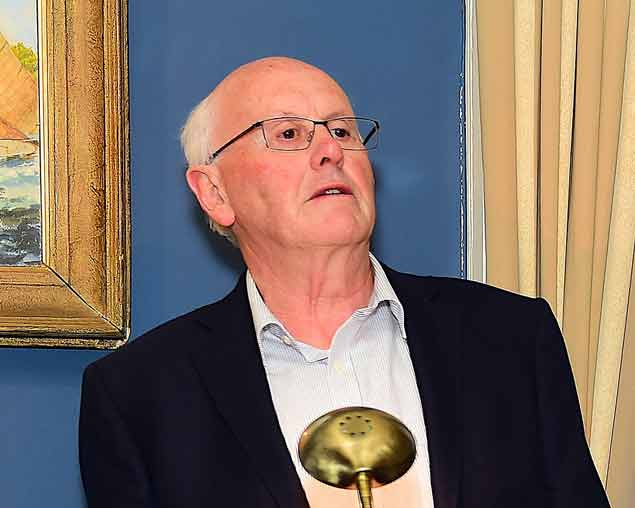 The founding Dingle Race organiser Martin Crotty reminiscing about the early days in 1993 at this week’s reception in the National Yacht Club. Photo Michael Chester
The founding Dingle Race organiser Martin Crotty reminiscing about the early days in 1993 at this week’s reception in the National Yacht Club. Photo Michael Chester

He and fellow owner Peter Cullen had been doing the 1992 Round Ireland Race with their hefty Sigma 41 Koala, and in slugging up the west coast into a particularly unpleasant northerly (I remember that one too), their mainsail went into several pieces on the latitude of Loop Head, so they retired and ran back to Dingle, a place they didn’t know at all.
They got to know it very well indeed over the next day or two, and the hospitality the little West Kerry port meted out to them – with the Dingle Skellig Hotel more or less providing open house – soon got them thinking that a race there rather than sailing all the way round the Emerald Isle would be an interesting alternative in the years when the biennial Round Ireland Race from Wicklow was not being staged.
Such ideas seem marvellous over a pint or three as midnight draws on, then fade from the memory. But there was some special chemistry already at work between the can-do Dun Laoghaire sailors and the maritime-minded folk of Dingle. Perhaps it’s because both ports think they’re the hub of the universe…… Whatever the secret ingredient, by 1993 in Dingle Harbour, Master Brian Farrell was ready to welcome the fleet, a new marina was in the making, and Dingle was on the cusp of an entirely new era.
 Dingle in the far west of Kerry has formed strong links with Dun Laoghaire in Dublin Bay, yet the two places could not be more different.
Dingle in the far west of Kerry has formed strong links with Dun Laoghaire in Dublin Bay, yet the two places could not be more different.
As for the Dun Laoghaire to Dingle Race, we knew it was fully part of the scheme of things by 1995, as Denis Doyle turned up to compete with Moonduster. Once that happens, you know your race has arrived, and “The Doyler and The Duster” were honoured participants for many years, encouraging some very substantial boats to subsequently take part, with new heights being reached in 2009 when Michael Cotter’s handsome 78ft Whisper brought a touch of global glamour and a new record, though she missed the magic 24 hours by 43 minutes and 45 seconds.
As each race succeeded its predecessor, a bonus emerged when it was acknowledged that the Dun Laoghaire to Dingle would count as a qualifier for the Fastnet Race, which would as usual be staged about eight weeks later. By this stage the race had so much going for it that it seemed impervious to setback, but like everything else in Irish life, it went through diminished times during the recessionary years.
 When “The Doyler and The Duster” (Denis Doyle and Moonduster) became involved from 1995 onwards, the Dun Laoghaire to Dingle race was made. This is a page from the August 199 Afloat magazine, with Moonduster much in evidence in the race report. The winner that year was Donal Morrissey’s GK34 Joggernaut from Galway, and in those days the start was in Dun Laoghaire Harbour.
When “The Doyler and The Duster” (Denis Doyle and Moonduster) became involved from 1995 onwards, the Dun Laoghaire to Dingle race was made. This is a page from the August 199 Afloat magazine, with Moonduster much in evidence in the race report. The winner that year was Donal Morrissey’s GK34 Joggernaut from Galway, and in those days the start was in Dun Laoghaire Harbour.
But then came 2015, and the numbers were back up, and then some. Having seen his pet project through times good and bad, Martin Crotty had indicated that this 12th Dun Laoghaire to Dingle Race would be the last he would personally administer, but already a strong successor was being briefed in the person of Adam Winkelmann. And in the 2015 race he had a vintage familiarisation to observe how it all worked, though as his mother Carmel was for many years one of the time-keepers, he started from a position of inside knowledge.
Over the years, the Dingle Skellig Hotel, which showed such generosity to the sea-battered crew of Koala way back in 1992 – leading to the inception of the race – has stayed on board as co-sponsor, and everyone’s longterm faith in the event was born out in 2015’s race, which was a classic. Before it, the atmosphere around the National Yacht Club was pure carnival, and while the start may have been slow, the winds soon filled in from the north and the fleet scampered down the east coast.
Out in front, the line honours battle was between Adrian Lee’s Cookson 50 Lee Overlay Partners from Dun Laoghaire and Anthony O’Leary’s Ker 40 Antix from Cork, and they went so well that for a while it looked like Antix might get the corrected time win. But holes in the wind at the Fastnet and beyond shook up the order, and by the finish it was glory day for J Boats, with the Shanahan family’s J/109 Ruth (NYC) winning by 20 minutes from her Pwllheli-based sister-ship Mojito (Peter Dunlop & Vicky Cox), the first foursome being very complete for the Johnstone brothers as the J/122 Aurelia was third and the J/109 Dear Prudence was fourth.
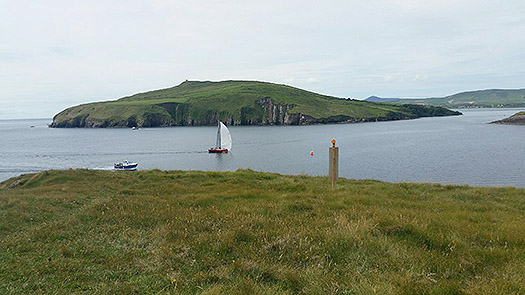 Anthony O’Leary’s Ker 40 Antix crossing the finish line at Dingle in 2015
Anthony O’Leary’s Ker 40 Antix crossing the finish line at Dingle in 2015
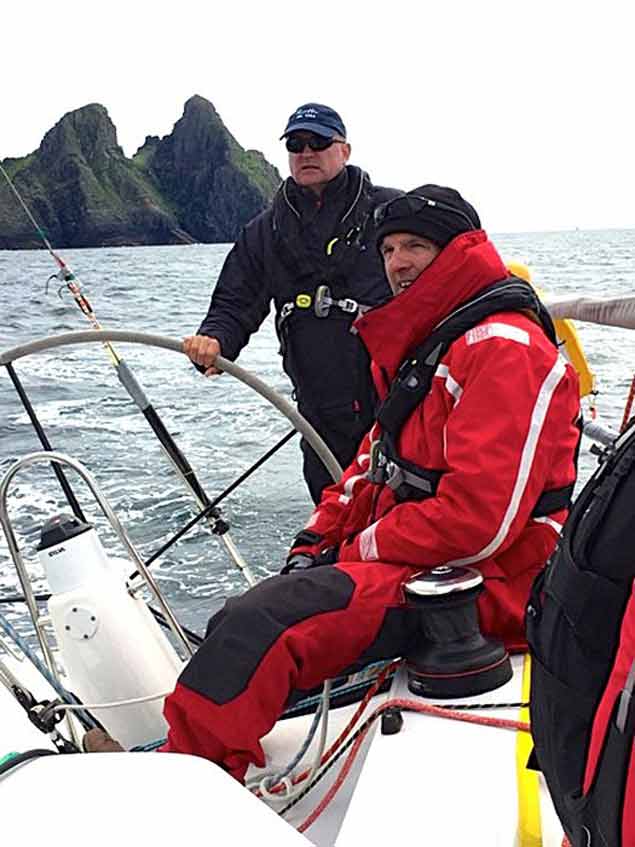 Overall 2015 winner Liam Shanahan at the helm of his J/109 Ruth with Skellig Michael put astern, and crewman Kevin Daly trimming the main for the final stage up Dingle Bay to the finish.
Overall 2015 winner Liam Shanahan at the helm of his J/109 Ruth with Skellig Michael put astern, and crewman Kevin Daly trimming the main for the final stage up Dingle Bay to the finish.
 After a rugged race, there’s nothing like an al fresco party at Dingle
After a rugged race, there’s nothing like an al fresco party at Dingle
But in a fascinating contest, almost every boat was having her day at one stage or another, and for those who were doing the race as a Fastnet qualifier, it came up trumps. Irish Offshore Sailing’s 36ft Jeanneau Desert Star may have only been in the middle of the fleet in the Dingle results, but her crew were on a learning curve and on top form by the time they did the Fastnet Race, so much so that they won overall in the 33-boat fleet making up the Sailing Schools Division, a well-earned dream result for skipper Ronan O Siochru.
So Martin Crotty handed over a prestigious event in really good order to Adam Winkelmann after all the D2D business was done and dusted in 2015, and this week’s launching reception in the National Yacht Club for what is now the Volvo Dun Laoghaire to Dingle Race was one of those gatherings which ticked so many boxes that we could get a month’s worth of Sailing on Saturdays out of it.
The heartwarming sense of continuity was palpable. Not only was Adam Winkelmann taking over the D2D from Martin Crotty, but in the host club, Ronan Beirne had been barely a wet week as the new Commodore in succession to Larry Power. To say that the speeches were in tune with the mood of the evening barely gets the flavour of it. It was a time for nostalgia, a time for relishing the present, and a time for keenly anticipating the future, with all aspects covered.
 Adam Winkelmann, chair of the Volvo Dun Laoghaire Dingle race Committee, reveals his hopes for 2017’s race and the races beyond. Photo: Michael Chester
Adam Winkelmann, chair of the Volvo Dun Laoghaire Dingle race Committee, reveals his hopes for 2017’s race and the races beyond. Photo: Michael Chester
It was Adam Winkelmann who summed it all up in a friendly presentation – he does it so painlessly that the word “speech” is way too pompous – effortlessly telling us about the new dynamic with the lineup with Volvo, the continued support from Dingle with the Dingle Skelligs Hotel joined by Crean Brewery – and the growing interest from the RORC with that club’s Janet Grosvenor – a very good friend to Irish offshore racing – planning to monitor the Volvo Dun Laoghaire to Dingle Race 2017 with a view to giving it greater recognition in the RORC’s 2019 programme.
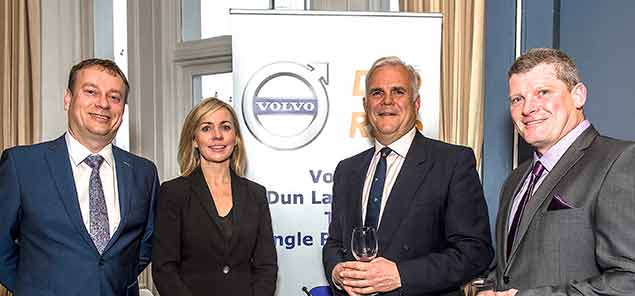 Graham Fitzgerald of the Dingle Skellig Hotel, Patricia Greene of Volvo Car Ireland, Adam Winkelmann, and Jerry O’Sullivan of Crean Brewery, Dingle. Photo Michael Chester
Graham Fitzgerald of the Dingle Skellig Hotel, Patricia Greene of Volvo Car Ireland, Adam Winkelmann, and Jerry O’Sullivan of Crean Brewery, Dingle. Photo Michael Chester
As it is, the 2017 race will start on the evening of Wednesday June 14th, which research among competitors has show is reckoned as the most user-friendly time for those fitting the race into work breaks, as it means you can definitely do a three day week, yet have every chance of making the clock-in at the workplace first thing Monday morning.
Thus the prize-giving will be on Saturday night, and it is being moved beck to the Dingle Skelligs’ sister establishment, Benners Hotel in the heart of town. As for the bigger picture, the timing also allows a useful gap before the Sovereigns Cup series starts at Kinsale on June 21sr, but while the start time will be tight for anyone who also plans to also do the ICRA Nationals at Crosshaven from Friday June 9th to Sunday June 11th, in times past we’d have reckoned that’s it a logistical challenge which is do-able, you just draw lots for the three guys who are going to take the boat to Dun Laoghaire as soon as the last race at Crosser is over.
As if that’s not enough of a challenge, Ric Morris has lately been airing a suggestion that it’s time to think seriously about an Irish National Offshore Championship based around the many events already in existence. He reckons that with the Round Ireland and the Dun Laoghaire to Dingle races alternating at the peak of this annual season-long series, we’d have an intriguing setup which has the potential to involve many boats – and he means many big time.
Certainly the imprimatur of the RORC on the Volvo Dun Laoghaire Dingle Race would give it turbo power, making it a serious points accumulator apart from being a superb race in its own right. Truly it has moved on a long way from being a handy little club-oriented event best used to position your boat in Ireland’s finest cruising ground. But we shouldn’t be surprised, when we remember that the Fastnet Race itself started in a very modest way in 1925. It was so shunned by the sailing establishment that it couldn’t get a starting line at Cowes, and had to be sent eastward out of the Solent from the start line of the Royal Victoria Yacht Club at Ryde.
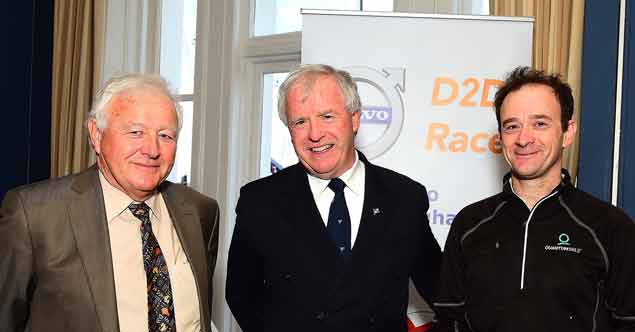 Brian Farrell, Harbour Master of Dingle when the Dun Laoghaire-Dingle race was inaugurated in 1993, Ronan Beirne the newly-elected Commodore of the National Yacht Club, and Yannick Lemonnier, who will be racing a Minitransat 650 to Dingle. Photo Michael Chester
Brian Farrell, Harbour Master of Dingle when the Dun Laoghaire-Dingle race was inaugurated in 1993, Ronan Beirne the newly-elected Commodore of the National Yacht Club, and Yannick Lemonnier, who will be racing a Minitransat 650 to Dingle. Photo Michael Chester
Presumably the RORC still sends the RVYC an annual Christmas card as a token of their appreciation of that display of faith way back in 1925, now that the hugely popular Fastnet Race is started from all the glory of the Royal Yacht Squadron line at Cowes.
And as for the Dun Laoghaire-Dingle Race in all its manifestations, while it has always been comfortably under the imprimatur of the National Yacht Club in Dun Laoghaire, the developing positive attitude towards sailing at official levels in Dun Laoghaire/Rathdown was underlined by the official presence at Tuesday’s gathering of Councillor Cormac Devlin, Cathaoirleach of Dun Laoghaire/Rathdown County Council.
But while the new turbo power of the Volvo Dun Laoghaire to Dingle Race was quietly in evidence at the party in the National YC this week, it was good to meet up with old friends from Dingle from the earliest days, particularly the former Harbour Master Brian Farrell whose enthusiasm for his job always went way beyond the call of duty.
There too were Brian Barry and Peter Cullen, both of whom did so much to put the show on the road and keep it there through times good and bad. But it was appropriate that also present was the one and only Yannick Lemonnier, who did the race in the two-handed division in 2015 (he was second to Howth’s Colm Buckley and Simon Knowles) but in 2017 will be doing it in a new special division which has been encouraged into the fray by the National’s Sailing Manager Olivier Prouveur.
Yes indeed – the Volvo Dun Laoghaire to Dingle race will be providing a start for Mini 650 boats, and Yannick Lemonnier will be right in the thick of it all. They’ll get a separate prize and won’t be in the IRC Division, but it’s a new twist in a race which, in 2017, will also have a new old twist.
 David Thomas, MD of Volvo Car Ireland, with Emma O’Carroll, also of Volvo Car Ireland, and Darryl Hughes, owner-skipper of Maybird, the first gaff-rigged entrant in the Dingle Race. Photo Michael Chester
David Thomas, MD of Volvo Car Ireland, with Emma O’Carroll, also of Volvo Car Ireland, and Darryl Hughes, owner-skipper of Maybird, the first gaff-rigged entrant in the Dingle Race. Photo Michael Chester
For no-one has any recollection of the Dun Laoghaire to Dingle Race ever having a gaff-rigged entry in its 24 years. Yet the madly enthusiastic Darryl Hughes has entered his beautifully-restored 1937 Tyrrell-built 43ft gaff ketch Maybird. He knows he’ll be doing quite well to make it to Dingle in time for the prize giving. And then he’ll have to think of further schedules, as he is also entered for the Classics Division in the Volvo Dun Laoghaire Regatta from July 9th to 12th. But in the National this week this week he was able to assure everyone that Maybird is already well n the way to being race ready. Sure hadn’t he and his mates scrubbed her and anti-fouled her – including a fresh boot-top – all on the one Spring tide at Poolbeg a couple of weeks ago? So the count-down is already well under way for the turbo-powered Volvo Dun Laoghaire-Dingle Race 2017.
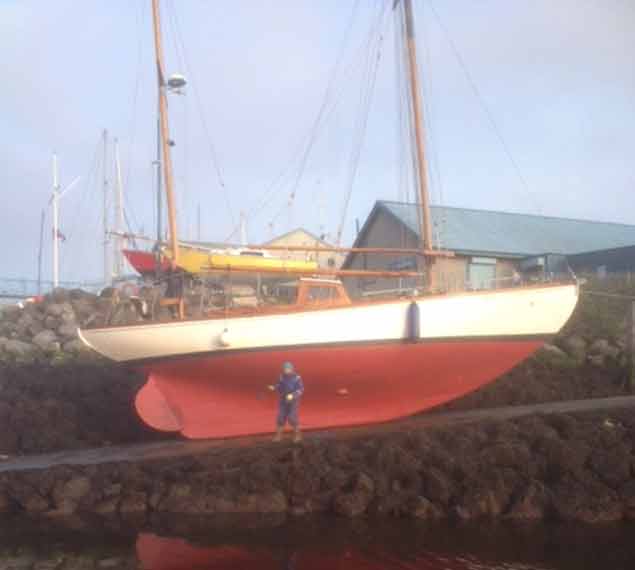 Race preparation. Maybird gets completely re-antifouled and with a fresh boot-top a fortnight ago, all in one tide at Poolbeg
Race preparation. Maybird gets completely re-antifouled and with a fresh boot-top a fortnight ago, all in one tide at Poolbeg
The National Yacht Club looks set to gain Royal Ocean Racing Club recognition for its mini–offshore Dun Laoghaire Dingle race as David O'Brien reports in the Irish Times Sailing Column this morning.
The Dun Laoghaire Dingle application is well timed because RORC Commodore Michael Boyd says the London–based club is keen to encourage RORC racing across the UK, not just Channel races.
The June 14th race – first hosted by the NYC and County Kerry’s Dingle Sailing Club in 1993 – is working closely with Dublin Bay Sailing Club (DBSC) and the Irish Sea Offshore Racing Association (ISORA) to develop the “mini-offshore” into an international race.
Incoming race chairman Adam Winkelmann is adding extra spice by adding a new title sponsor and recruiting a French Mini–Transat fleet.
RORC will assess this Volvo-sponsored edition of the race with a view to adding the race to its points series in 2019.
Read the full story in the Irish Times here and more on this year's D2D race here
RORC Announce Two New GBR IRC Championships
The International Rating Certificate (IRC) global rating rule is used for hundreds of events in 40 countries. In UK waters IRC competition is fierce both for the National Championship, organised by the Royal Ocean Racing Club, and for regional championships which range from Scotland to the Channel Islands.
Two new IRC Championships have been added for 2017: an Inland Championship on Lake Windermere and an Autumn Championship organised by Hamble River SC – both add an extra challenge to an existing winter series. In addition to regional events there are championships for Small Boats and Double Handed crews.
Winners of each Championship will also win a special prize package from IRC sponsors Spinlock.
The 2017 GBR IRC Championships are:
Solent (May-October)
Scottish (May)
Sussex (June)
Channel Islands (June)
National (June)
East Coast (July)
Welsh National (August)
South West (August)
Southern (September)
Small Boat (September)
Double Handed (September)
Autumn (September)
Inland (November-March)
Smaller Boats Not Welcome at IRC Euros 2018?
The significance of the RORC decision to merge the Commodore's Cup with the IRC Europeans in 2018 has extra meaning for Ireland given at least half of the Irish fleet will not be eligible to race due to a ratings band change.
RORC has set a lower rating limit of 1.000 so that means, for example, first and second overall at the 2016 Europeans (Irish boats, Anchor Challenge and Harmony) will not be able to compete in 2018.
It is a vastly different situation to that which existed for the inaugural Euros at Cork Week 2016 and also this year's event in Marseilles. The 2017 event has a minimum limit of .900 allowing them this year.
Details of the 2018 event were published by Afloat.ie yesterday here.
Ireland's fleet has a lot of sub 1.000 boats, but particularly the growing Quarter and Half Ton classes.
Two of the strongest classes at the ICRA championships are class 2 and class 3 and effectively IRC organisers (UNCL and RORC) are not giving them a place at their own European championships.
No doubt this is something that will be addressed tomorrow at the ICRA conference in Limerick where RORC will be in attendance and can give an explanation.
'It appears RORC are trying to resurrect the dying Commodores Cup by attaching it to the IRC Europeans, and in so doing is telling smaller, often less wealthy owners, that they are now not interested in them, a leading Irish IRC racer told Afloat.ie'.
A change to a lower limit that at least includes the Half tonners would be to Ireland's advantage.
June 2018 will see the cream of the IRC fleet gather in the Solent for an exciting 12-race multi-disciplinary team and individual regatta. The Commodores' Cup, a team-based keelboat event, has been running every other year since 1992 and has seen incredible competition amongst amateur-sailed IRC rated offshore keelboats representing various countries and geographical regions.
One of the main reasons for its success has been the way the racing has incorporated a variety of different courses ranging from short windward-leeward sprints through round the buoys and long day races in the always challenging Solent, along with one serious offshore race sailed around the central Channel. Demand for this successful multi-disciplinary event has stretched beyond the team format and amateur based event only and so for 2018 the event organiser, the Royal Ocean Racing Club, has responded by offering the same event to a wider audience.
The most active and competitive IRC racing boats fall into the rating band 1.00 to 1.27. This fleet has had its own European Championship held at various racing venues. In 2016 it was held in Cork, Ireland and in July 2017 it will be held in Marseille and in 2018 the IRC European Championship will take place in Cowes, and incorporate the Commodores' Cup. It is expected to attract up to 100 individual entries over the nine-day period (8-16 June 2018).
The European Championship will be an Open event, meaning that amateurs and professionals will race each other and the presence of professional sailors on board the entries is unrestricted. However ,to compete for the Commodores' Cup within the championship, each three-boat team will be restricted to just one World Sailing Category 3 sailor per boat.
"It is very exciting to see the Commodores' Cup format used for individual competition. The challenge of inshore racing, coastal racing and offshore racing has been popular with the boats that have competed in the regatta in the past, and now being able to produce an individual champion has the potential to be hugely attractive," declared Nick Elliott, RORC Racing Manager.
Whether you are preparing for the Keelboat World Championship, looking to have fun with amateurs only, wanting to represent your country on the water or just keen on the challenges represented by serious competition in the Solent and waters of the English Channel, this will be a really attractive event and may well turn out to be the most competitive IRC keelboat regatta in 2018.
ICRA Debate – Running The Rule Over IRC & ECHO Handicaps
The Irish Cruiser Racing Associaton (ICRA) has called for debate about the future direction of Irish cruiser–racing at Saturday's national conference in Limerick. Here, Brian Turvey makes his contribution by describing how IRC and ECHO rating systems work in Ireland and why there is concern over the availability of free handicapping software. The former Howth Yacht Club Commodore asks how ICRA can capture all cruiser-racing boats and add value to the sport because, he says, the future of cruiser-racing relies on ICRA starting to think more creatively.
Most racing sports appear relatively straightforward to the uninitiated and only reveal new layers of complexity as you become more involved and enthused to watch or participate. Consider Formula One racing, it seems straightforward - scream around the course faster than anyone else and you win. Horse racing in Britain now boasts that more than 60% of their sport is now categorised as handicapped, a departure from the principle of 'first past the post' by adding weights in a calculated effort to reinforce what is considered to be a sport of chance and potentially allow any horse and consequently any punter to win.
Then consider the sport of yacht racing, commonly recognised to be the most complicated sport to learn and there is little dispute that it is the most complicated of all to follow. Most sailors have attempted a well-intentioned explanation of the sport to a non-sailor, but very few are gifted with the skill to articulate it and fewer manage to retain the attention and interest of even the most fervent of enquirers.
But explaining the concept of yacht racing is only the first layer. Now add the much-used rating handicap systems. The goal of trying to narrow and equalise the finishing time of all competitors in a race is common to lots of sports and based on a measurement calculation, the first version was standardised in yacht racing during the 19th century. There have been many variants and evolution of the original formula and rule, with the dinghy-measurement version 'Portsmouth Yardstick' (PY) being the winner for longevity.
 Mixed dinghies race under a Portsmouth Yardstick rule
Mixed dinghies race under a Portsmouth Yardstick rule
Endorsed by ICRA and the Irish Sailing Association (ISA), the system currently preferred by more than 7000 boats worldwide including most Irish and British yachts is the RORC's 'IRC Rating.' Closely monitored by yacht designers and engineer-types, it is essentially a formula that uses various boat measurements to calculate a rating number. When each rating is applied to every boat in a race and all other factors being equal, the factor-adjusted elapsed time should have every boat finish equal, or so the concept should work. And it does, for the most part. The theory and practice would be that those crews who best optimise their performance during the race, will win.
But as the designers get smarter and yesterday's yacht tumbles in value (unlike racehorse ownership, this is not a speculative investor's arena), the rule-masters in the RORC have to stay alert and agile to keep pace and keep relevant for their broad range of customers. However, they will always be 'followers', at best reacting a-season-too-late to those design enhancements that would otherwise render older racing designs obsolete much faster than their owners would stand for.
One-design sailors tend not to understand the attraction and complexity of IRC racing, by preferring to gravitate towards a class that offers localised 'critical mass' that might promise solid investment in relative terms and suggest many years sailing in a vibrant and competitive class. Which is all fine and dandy, but the leading edge of design development will more often be tested and refined in 'mixed-design' racing. Designers such as Mills and Corby revel in the challenge of one-off racing yachts, while the production-line manufacturers like Jeanneau and X-Yachts have to stay sharp with their designs, because producing anything less than competitively-rated racing boats from a production line would be calamitous.
So buying a well-rated IRC cruiser-racer is a bit like committing to the latest gadget, it will be out-performed in no time by the next best thing, albeit with some notable exceptions. What then for the enthusiastic racing owner of an older or lesser-rated design? Giving 5 minutes per hour to boats that frequently cross the line ahead of them will wear the enthusiasm for the sport from owner and crew in no time. There is a safety net and it is in the form of the next layer of complexity in cruiser-racing: Performance-Rated Handicapping.
Built under the guidance of the then ISA President Paddy O’Neill, ECHO (East Coast Handicap Organisation) was created by a team of Irish amateur sailors including Ernest Gouding, Hal Silk, Billy Lacy, Chris Bruen, Arthur Barker, John Deane and Chick Brown who all brilliantly blended their interest in sailing with their maths skills. The system has grown to be the main performance-based cruiser racing handicap system in Ireland and has in recent years been adopted and adapted internationally alongside measurement rating systems such as IRC and ORC.
With help from the Dublin Bay Sailing Club’s Brian Barry, it was integrated into a unique database-structured sailing results system built by Colin McMullen for DBSC and Howth Yacht Club. Colin had the distinction of being the only professional computer programmer in the world who was a sailor. ECHO, which was known in certain circles as as ‘Earnest, Chris Hal and Others’, is best compared to handicapping in horseracing, but by adjusting the elapsed time instead of saddlebag weight.
Calculated by and based on previous performance history, the formula calculates a rating for every boat that should have all boats finish on equal time. Whilst this desired end-point is similar to that of the measurement-based rating, it has a very different rationale. ECHO is designed to reward crews that out-perform their recent average results. The theory being that any boat can win, relative to their own performance history. The actual specification and design of boats is irrelevant and in theory, the slower and obsolete designs now have every chance of winning under ECHO. The ‘lower end’ of the fleet have something to race for, encouraging crew on the lesser competitive boats, eliminating the ‘what's the point’ factor, whilst maintaining and encouraging participation. Everyone's a winner, well perhaps not quite...
For ECHO to work optimally as per the concept, it relies on 'consistency' and all the possible variables need to be removed, or minimised at worst.
• The same boats and same number of boats must be continually racing against each other in each race. Every deviation in numbers competing and/or infrequent entries will alter all boats handicaps accordingly. This makes it at best very difficult, but normally impossible to assign initial handicaps to a mixed fleet of boats that haven’t recently nor regularly raced together. In these circumstances a ‘link’ boat is used where there is found to be a record of it racing against the other boats before, but it rarely works, because ECHO works best with local fleets.
• ECHO's focus is on the relative difference in performance of a boat (particularly the crew), so a change in personnel will often alter performance and therefore another variable is introduced. It should be noted that there is an obligation on boats racing under ECHO to declare substantive changes to crew, but in practice, most changes go 'under the radar' and rarely get declared.
• Any variation from the average/normal in weather conditions will affect the mean calculations. For example, lighter than average winds might favour the lighter displacement boats.
• Any alteration in the type of course (from the average) will introduce another variable. Different boat designs will vary in performance on specific up wind, downwind and reaching legs.
• There is also the issue of 'sandbagging' or deliberately underperforming in order to reduce ECHO rating and use this in the next or later race to advantage. This is very difficult to prove in competitive fleets, because a boat can lose places very easily and in genuine circumstances.
The ECHO administrators allow direct manual intervention to address anomalies such as these, but a results system that affords interpretive adjustments could be seen to be subjective and potentially ambiguous. Single race regattas are the most problematic, where new boats are added without previous integration in that fleet. Interestingly, it seems to work in the potentially controversial sport of horse racing without complaint.
ECHO is often erroneously compared to a golf handicap, but has little in common other than being performance-related. Golf handicaps are not derived from team performance, it is one person versus the course and the other competitors have neither influence on nor an ability to intentionally affect an opponent's score. Golf is not a race. Performance-rated yacht racing is almost always a team-sport, where with certain probability, every race will mean a change in performance by at least one boat, necessitating handicap revisions to all.
The step towards ‘progressive’ maintenance of ECHO handicaps was a welcome one for racing sailors that embrace the performance handicap, because it readjusts after every race. (ECHO used to only adjust periodically, often causing consternation in fleets by huge changes happening at one time.) However, as a consequence of this, it is almost impossible for an experienced and ECHO–savvy competitor to determine their actual standing during a race – what must it be like for the newbie or spectator? Whatever the difficulty with deducing the standings during an IRC race, performance handicap races are absolutely not spectator events.
But to be stressed out about the accuracies and anomalies of this system is futile. It will raise the passions of many a sailor, particularly when a calculation seems to produce an unfair result. Like measurement ratings, ECHO handicapping is not a pure science, but with the probability of so many variables, sailors need to know that it is always imperfect.
With the development of relatively simple sailing results software and the adoption of ECHO-type systems by sailing clubs and classes across the world, it is now possible to use this software for most sailing events and club racing. Lots of one-design classes have effortlessly added performance handicap prizes to their traditional ‘scratch’ races and events. Club volunteers who are using software packages such as Sail 100, SailWave and Top Yacht can now set up performance handicapping for dinghies, one-design keelboats and for cruiser racing in addition to providing results for Scratch, PY and IRC. This is now an attractive proposition for many clubs, because performance handicapping works best for local fleets where the same boats and sailors race together frequently.
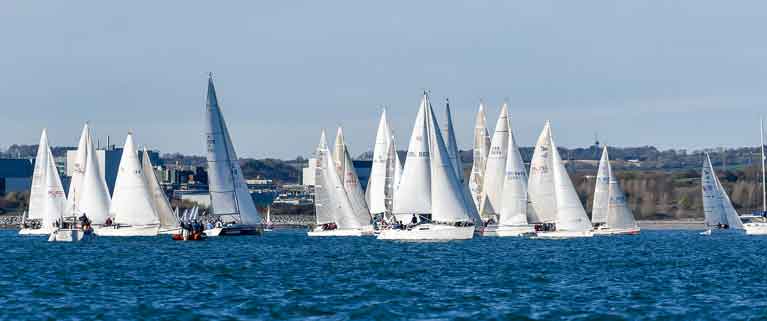 A wide range of different cruiser and sportboat types combine for all-in club racing. Photo: Bob Bateman
A wide range of different cruiser and sportboat types combine for all-in club racing. Photo: Bob Bateman
So how might this affect the future for ECHO in Ireland? The ‘elephant in the room’ and big consideration for the ISA and ICRA is that ECHO-type software programmes are now freely available and ideal for local club racing. Why then might a regional club or class need to use or pay for ECHO? It will naturally be conditional that the major regattas such as Volvo Dun Laoghaire and the ICRA Nationals insist on IRC and ECHO affiliation, but what for the local regattas when dinghies, powerboats and all sorts can use this software freely?
The current handicap registration process for cruiser racers in Ireland sees ICRA ‘pass the ball’ to the Irish Sailing Association to oversee the administration of IRC, ECHO and consequently the management of ICRA membership. With over 450 registered ‘member’ boats, ICRA really needs to take control of its own destiny. Their funding comes from an agreement with the ISA, who return a ‘slice’ of the revenues collected for racing certs (IRC and ECHO), after an administrative fee is deducted. A recent straw poll of the racing classes in Ireland would suggest that the average annual subscription for the various keelboat classes wanders between €50 and €100. One might imagine that a class that boasts about having thousands of participants should at the very least be able to raise €50-€100,000 of its own funds each year. But if there is danger in tagging their subscriptions through the ISA to an ECHO system that could now freely transfer to clubs and classes, and an IRC certification system that is already wary of international trends and new local interest towards ORC, then it’s time to think more creatively.
How might ICRA capture all cruiser-racing boats and add value where the ‘what’s-the-pointers’ need to be encouraged to participate in a national racing organisation? For instance, it’s possible that moves towards the national licensing and registering of vessels could provide an opportunistic inlet, although it would mean that the ISA would need to partly relinquish what would be its national governance – perhaps unlikely.
Taking control of a database-built results system might also afford ICRA (and other classes) to take responsibility for their members and racing administration – it would certainly help with sharing of performance handicap data and add value for clubs, classes and sailors. However, it has been suggested that the set-up cost would be prohibitive.
To survive as an organisation, ICRA must be an organisation – taking control of its own finances and of its own management of the Association.
The ICRA National Conference is being held in Castletroy, Limerick on Saturday and is themed ‘We must talk about cruiser racing’ and it’s certain that there will be lots of lively talk.
Brian Turvey
More Winners Announced In RORC Caribbean 600, Early Finishers Video
The early finishers in the RORC Caribbean 600 have been captured on video, reviewing their races in both multihull and monohull classes.
Irish sailors finished first and fifth in this year's edition of the race that was decided yesterday.
Organised by The Royal Ocean Racing Club in association with Antigua Yacht Club
The 80-boat fleet started in Antigua, West Indies on Monday, 20 February and sailed a non-stop Course of 600nm around 11 Caribbean Islands.
As dawn broke on Day 5 of the RORC Caribbean 600, crews who had finished the race were beginning to arrive back in Antigua. Every boat, regardless of where they were moored, was met by the RORC Caribbean 600 volunteers, armed with a celebration banner and cold beer. The restaurants and coffee shops around Falmouth Harbour were filling up with sailors, hungry for a square meal full of stories about their RORC Caribbean 600.
 |
| Class40 winner by just 33 minutes, Peter Harding's Ph-orty © RORC/Ted Martin |
At Dawn on the fifth day, the leading Class40s were approaching the finish. Throughout the race, the battle in the class had been intense, with three yachts taking the lead at various points along the course. Peter Harding's Ph-orty was leading at Redonda, just ahead of Catherine Pourre's Eärendil and Halvard Mabire's Campagne de France was in third. All three yachts started the beat to finish with a chance of victory. However, Eärendil's main halyard broke as the team hardened up for the beat and they were forced to reef and re-hoist. Ph-orty extended on the beat to take the gun and the class win by just 33 minutes. With Eärendil under-powered, Campagne de France closed the gap and overtook them, just before the finish line, to snatch second place by just under two minutes.
 |
| An emotional win in IRC One for Antigua's Bernie Evan Wong and his crew on the RP37, Taz © RORC/Ted Martin |
 |
|
Ed Fishwick's J/122 Redshift on El Ocaso secure overall win in IRC Two. Crew for the RORC Caribbean 600: Nick Cherry, Robert Hillier, James Holmes, Ed Males, Luke Patience, Alan Roberts, Nick Bubb and Tom Whicher © RORC
|
Hap Fauth's American Maxi72, Bella Mente has been declared the overall winner of the RORC Caribbean 600 Trophy. Whilst yachts are still racing, none of the fleet can beat Bella Mente's corrected time under IRC. This is the second time Bella Mente has won the race overall and was a sweet victory after retiring last year with keel problems.
Irish in First & Fifth Overall In RORC Caribbean 600
Things are very sweet for the Irish contingent in Antigua at the moment with the leaderboard showing our presence in first and fifth places overall, together with the multihull and overall line honours, in the RORC Caribbean 600 2017 writes W M Nixon.
As Afloat.ie reported earlier, the Ian Moore-navigated JV 72 Bella Mente (Hap Fauth, US) just got better and better the nearer she got to the finish line off Antigua, and in the end had a convincing margin of an hour and twenty minutes on corrected time over the 2016 winner, the Maxi 72 Proteus, and is now virtually unbeatable by any other boats.
Meanwhile, currently indicated as finished and lying fifth overall is the hundred foot Leopard, aboard which is Tom McWilliam of the Crosshaven sailmaking dynasty.
After another day of looking at this craziest of RORC courses, we’ve moved on from seeing it as a bowl of spaghetti or a cat’s cradle to a bulimic Dalek. But whatever it is, Ian Moore has done a textbook job on it.
 Outline sketch for a bulimic Dalek? The RORC Caribbean 600 course gets odder and odder the more you look at it.
Outline sketch for a bulimic Dalek? The RORC Caribbean 600 course gets odder and odder the more you look at it.
Meanwhile others working their way round this geography lesson on the middle section of the Lesser Antilles include Tim Goodbody, Aine Hanvey and Paul O’Donoghue, they’s fifth in Class Zero in the enormous Danneskjold with 32 miles to sail, while Barry Hurley and James Murphy are on Pata Negra in Class 1, they lie 6th in Class with 149 miles to go.
Things are looking a bit less rosy at the moment for Storme Delaney and Ciara Scott in Sunset, they’re 7th in Class 2 with 214 miles to go, while the First 40 Arthur Logic – which has shown in the top ten at various stages – now lies 9th in IRC 2 with her crew including Wicklow’s David Ryan and Jim Cummins, and they’ve 202 miles still to sail.
It must seem a very long way when they remember that Damian Foxall and his shipmates on Phaedo 3 finished after just 33 hours of sailing to knock off 600-plus miles and take line honours big time



























